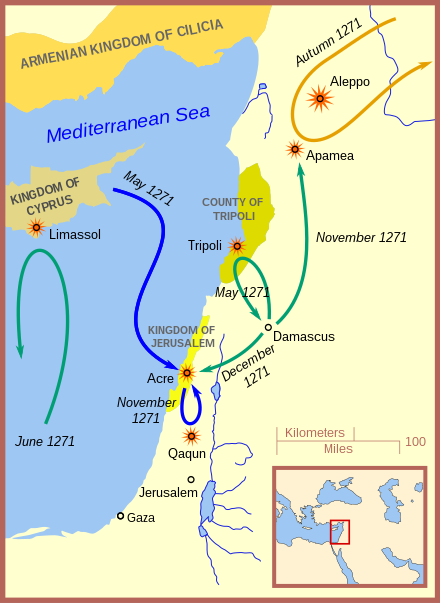THE NINTH CRUSADE (1271–1272).

The Ninth Crusade (1271-1272) was a military expedition to the Holy Land led by Prince Edward of England (later Edward I). It was an extension of the Eighth Crusade which occurred in 1270 led by Henry of France, this particular Crusade was the last of the Crusades to reach the Holy Land before the fall of Acre in 1291 brought an end to the permanent Crusader presence there.
PARTIES INVOLVED
The main parties involved in the Ninth Crusade were:
The Crusaders: Led by Prince Edward of England, the Crusader force also included contingents from France, Germany, and other European countries.
The Mamluks: The Mamluks were a military slave dynasty that ruled Egypt and Syria at the time. They took power from the Ayyubids and they were the Bahri clans of the Mamluks. They were very known for their military prowess especially the victory of Ain Jalut against the Mongols in 1260. They were the main opponents of the Crusaders in the Ninth Crusade.
OVERVIEW
The Ninth Crusade was launched in response to the growing power of the Mamluks, who had conquered most of the Crusader states in the Holy Land. Edward set sail for the Holy Land in 1271, and arrived in Acre in September of that year. He was initially successful in capturing the town of Nazareth and fortress of Qaqun, but was unable to make any further gains against the Mamluks because they did succeed in preventing the Crusaders from making any significant gains or achieving their main goal. The Battle of Montgisard in 1272, in which Edward of England defeated a larger Mamluk force, was the only major battle of the Crusade. Edward defeated the Mamluks at the Battle but this victory was not decisive. The result was that both sides has to settled for a ten- year truce which sent the Crusaders packing especially due to the fact that Edward was forced to return to England in 1272 due to the death of his father, King Henry III.
**Events
Here is a chronological account of the main events of the Ninth Crusade:
Arrival of Edward: On August 5, 1271,Prince Edward of England sets sail for the Holy Land.
Siege of Qaqun (1271): The Crusaders, under Edward’s command, launched a campaign to capture the strategically important fortress of Qaqun. The siege was successful, resulting in the capture of the fortress from the Muslims.
Battle of Montgisard (1272): Edward defeats the Mamluks at the Battle of Montgisard but they were not able to exploit this victory because it was not a decisive one.
Truce Negotiations: During the course of the Crusade, Prince Edward engaged in negotiations with the Mamluk Sultan Baibars to establish a truce. The talks, although promising, did not result in a lasting agreement.
Death of King Henry III and Edward’s Return (1272): In the midst of the Crusade, Prince Edward received news of the death of his father, King Henry III of England. Edward decided to return to England in 1272 to ascend the throne as King Edward I, marking the end of the Ninth Crusade.
OUTCOME
The Ninth Crusade was a mixed bag for the Crusaders. Edward achieved some initial successes, but was unable to make any lasting gains against the Mamluks. The Crusade ended with the signing of a ten-year truce between the Crusaders and the Mamluks.
CONCLUSION
The Ninth Crusade was the last major Crusader expedition to the Holy Land. It failed to achieve its objectives of recapturing lost territory and securing the Crusader presence in the region. The Crusade also marked a turning point in the Crusades, as the Mamluks emerged as the dominant power in the Holy Land.
